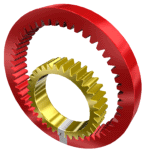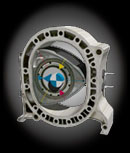|
|
|
|
 |
|
|
|
|
|
|
 |
|
|
Rotary Engine 101: Mechanics
|
|
|
Okay, now that you have seen that the rotor motion is really just a combination of two simple motions, rotation and orbit, let's look at the actual mechanism by which the planetary motion is produced.
The rotor's orbit is simply a result of the eccentric position of the rotor journal with respect to the center of rotation of the eccentric shaft. As the eccentric shaft turns, the rotor orbits. That's the easy part. What's responsible for keeping the rotor rotating at the proper 1/3rd forward rate of the eccentric shaft, relative to the rotor housing (or 2/3rd backwards relative to the rotor journal) is something called Cycloidal gearing -- more commonly associated with watchmaking.
|
|
 |
|
|
|
|
Cycloidal gearing is where one gear has the typical outward-facing teeth (called an External Gear) but the other has teeth facing inward (called an Internal Gear). This might seem strange, but it's quite space efficient. Both gears turn normally, just as in a conventional gearing application where the teeth face outward and the gears are mounted tangentially. The gear ratio is determined by the tooth count, which correlates directly to relative size of each gear (teeth are the same size, so a larger gear has more teeth). The gear set to the left is a 2:3 ratio, with the small gear having 34 teeth and the larger one 51 teeth. Notice how it takes three revolutions of the large gear and two revolutions of the small gear to get back to the starting point. |
|
|
 |
|
|
typical cycloidal gearing
[498K Animated GIF]
|
|
 |
|
| In rotary applications, however, the small external gear is fixed and the larger internal gear moves eccentrically. The external gear is appropriately called the Stationary gear, while the internal gear is simply referred to as the rotor's Internal Gear. Since the internal gear is affixed to the rotor, which is orbiting on the eccentric shaft rotor journal, the eccentricity of the internal gear is that of the rotor. As before the two gears are of a 2:3 ratio, with a tooth counts of 34 and 51 for the small and large gear, respectively. Basically, this results in one rotation if the internal gear (and thus the rotor) requiring three orbits of the eccentric shaft journal (i.e. three rotations of the eccentric shaft). |
|
 |
|
|
planetary cycloidal gearing
[399K Animated GIF]
|
|
 |
|
|
|
 |
|
|
|
 |
|
|
[ HOME ] [ ANIMATIONS | RE 101 | ADVANCED | ENGINE GUIDE | RESOURCES ]
|
|
|
Copyright © 2001 by Blake Qualley. All Rights Reserved.
|
|
|
|
|
|
|
|
|
|
|
|
|
|
|
|
|
|
|




